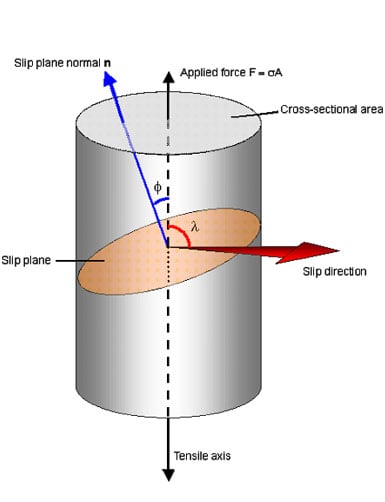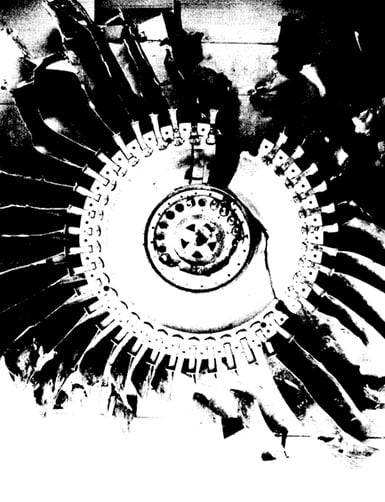Fatigue Life - Part 3
PART III: Design example for Fatigue Life & Conclusions
Given all of the information and considerations presented above, if we are able to establish a reasonable S-N curve for our selected material and conditions, there are some tools available that do a good job of predicting the fatigue life for metal parts. The simplest and most obvious is the design of parts whose maximum expected stress does not anywhere exceed the fatigue limit for the material - known as the “infinite lifetime” approach. However, using this approach is not efficient, though it is very safe in most cases. Parts designed this way will survive indefinitely, but will likely also be significantly heavier or more expensive than they really must be in order to function as intended. A well-designed part will contain only as much material (i.e., mass) and complexity (i.e., cost to manufacture) as necessary.
Other approaches that are commonly used in modern design are also based on the S-N curve data. These approaches take various possible forms, but are all designed around the idea that parts will fail eventually, and that this must be accounted for. They are[13]:
- Fault-tolerance - allowing parts to fail and be replaced. The system must be designed not to destroy itself when parts fail.
- Adding safety retention wires to fasteners in aircraft and other sensitive applications to prevent them damaging other components if they break is an example of this approach
- Safe life - parts are conservatively designed and carefully analyzed to determine with high confidence the service life for parts, which are replaced before they accumulate enough damage to fail.
- Modern cars and many other products use this approach to create parts using the least amount of material/processing possible while ensuring a known service life
- This can also be used for planned obsolescence
- Damage tolerance - parts are assumed to begin service with some damage/cracking present. Parts and applied environment are monitored via a number of methods to ensure they remain safe, or to repair/replace overly damaged parts before they fail.
- This approach is common in aircraft and reflects the fact that most fatigue life occurs between the formation of micro-cracks and their growth into ‘long’ cracks, which reach critical intensity quickly thereafter
- Frequent inspections and good predictions for crack growth are required
- Parts will be preemptively replaced if a set damage level or hours of operation threshold is exceeded
Regardless of which approach is used, we must understand quite well the loads being placed on the part under consideration, either via classical engineering analysis techniques, physical testing, or a more modern approach such as Finite Element Analysis (FEA). We need to have a good understanding of what stresses exist in the part and where they concentrate due to responses in the applied loads we are expecting to see. In addition, and just as critical, we must have a good grasp of the nature and amplitude of the cyclic loading present, its sources, and the required number of cycles the part must survive.
The topic of predicting vibration loading and environments, along with the prediction of structural resonances in a mechanical system is both a fascinating and also an enormously important one--worthy of an entire series of long blog posts! We will assume here that we have already dealt with these issues and have a good understanding of the cyclic loading environment and structural responses which could lead to destructive amplification of vibrations due to structural resonance.
.png?width=512&name=BESBlog_Fatigue_%20(16).png)
Drawing of a fatigue-failed steam locomotive axle, 1843 (Joseph Glynn) w/ failure location marked as “A”[13]
Since the tragic French train derailment of 1842 was one of the seminal events which led to the field of fatigue design and engineering analysis, it is fitting to use it as a brief example (originally shown above) of design for fatigue life using Solidworks CAD and FEA tools. We assume the axle is made of ductile iron, and that the mass of the locomotive is split up among the various axles and so we assign a (very arbitrary) mass of 10,000kg to a contact area on the top of the axle. The wheel is assumed to be a somewhat flexible spring attached to the small surface near “B”, and is where the axle is supported. The middle is assumed to be symmetrical with and influenced by the other end of the axle (not modeled).
.png?width=512&name=BESBlog_Fatigue_%20(17).png)
CAD Model of 1842 Locomotive axle and FEA loads and fixtures
.png?width=600&name=BESBlog_Fatigue_%20(18).png)
FEA Results for 1842 Locomotive axle for static loading
When the FEA model for the shaft above is solved (the applied loads and wheel stiffness are somewhat arbitrary for the purposes of getting informative results), the highest stress concentration is indeed at the same location where the historical shaft fractured in service. However, the maximum stress is definitely below the yield strength for ductile iron, and so we might innocently assume all is well with this design and build our locomotive with it. Furthermore, the modal analysis shows that the first resonant frequency for the axle is almost 500Hz, and so unlikely to be a problem for a slowly turning axle in an old steam locomotive. It is rather important to observe that due to how the axle is loaded, the surface is under tension on the bottom of the axle and under compressive loading on the top surface. Since the axle is turning, these stresses are constantly reversing, creating a more rapid crack development and propagation process than for non-reversing loading.
The common method for FEA-based fatigue analysis is to use the expected static loading results and to flex the part through a specified number of cycles, where one can select either fully-reversing or zero-based loading, depending on the correct situation. The correct S-N curve must be input to the model to get useful results. For the train axle, the load is fully-reversing, since the axle experiences cycling loading every time the wheel on it rotates. The fatigue plots show that, exactly as occurred in the historical shaft, the part will fail around stress concentration predicted at the transition from the wide center section of the axle to the wheel mounting after ~100,000-500,000 cycles. As mentioned above, the area most vulnerable to fatigue damage is on the surface of the part, which is also shown in the damage plot, shown below).
.png?width=512&name=BESBlog_Fatigue_%20(19).png)
Fatigue-damage plot from Solidworks FEA for 1842 Locomotive axle
Several approaches are immediately available to the engineer wishing to address this problem. Firstly, the part could be inspected in service for formation of cracks in the suspect area, and replaced immediately upon finding them, or replaced at 75,000 cycles (as a safe guesstimate). However, it is usually more desirable to design out a problem such as this unless it is unavoidable, to avoid expensive/error prone maintenance and replacement programs. The best solution here would likely be to change the part geometry and how the loads are applied and supported to reduce the stress concentration in the zone of failure, or use a better material (not an option in 1842). Also, it is common practice to specify a fine, perhaps even polished surface finish on highly stressed parts in order to reduce the presence of surface defects which become crack initiation sites.
Another area of concern to the fatigue life designer is that certain combinations of compressive/tensile stresses will reduce the S-N curve strength of a material somewhat further (fully reversing loads). Earlier, we saw that most metals are stronger in compressive fatigue than tensile fatigue loading. This has some positive benefits that will be discussed in the next section on material science solutions to fatigue problems. In any case, the success of a fatigue analysis depends most strongly on:
- Good knowledge of applied loads and environment
- Correct S-N curve adjusted for the specific operating conditions and cycle life
- In some situations, this may require building and testing some sample parts to failure under the most realistic conditions possible
- The Goodman curve approach may also be used to adjust an S-N curve for alternating stresses with a constant applied stress added if tools like FEA are not available
Material Science Approaches for Fatigue Life Improvements
It is useful to know that higher-performance alloys of metals are often created because the addition of another element into the crystal structure geometrically interrupts the slip systems of the crystals by interspersing atoms of a second (or often more) metal into the system in a controlled way. Metals can be made to have enhanced material properties as well as improved resistance to corrosion and other problems via this approach. Some metals (like iron) are highly suitable for static loading (i.e., they are very strong), but may be too brittle and fail quickly in a fatigue application.
The variation in the stress-strain curves for 4340 steel, a titanium alloy, and Waspaloy (a nickel-based superalloy) for static vs. cyclic loading are shown below. In the case of steel and titanium, the cyclic loading reduces the yield strength significantly (as shown in an S-N curve!), but for Waspaloy it is actually stronger in cyclic loading! Waspaloy is an exotic metal and very expensive to make parts from, so one would not use it unless the benefits of its unusual properties outweigh the costs of selecting it. This is one of several reasons why selecting the correct material for the design application and fatigue are both complex and critical. In some extreme cases, a special steel or alloy may need to be formulated and manufactured to meet the requirements of the project.
.png?width=512&name=BESBlog_Fatigue_%20(20).png)
Stress-strain curves for various metals in static and cyclic loading[8]
Other methods for improving the fatigue resistance of metals also exist. Since most metals are strongest in compression and often fatigue failures occur in areas under tensile loading, it is a long-known trick to introduce compressive stresses into a part to improve fatigue resistance. This can be done in a number of ways, but shot-peening may be the most common, where the part surface is bombarded with steel shot or other blows to cold work the surface and create high local compressive surface stresses. These areas of stress actually help interrupt and prevent slip due to tensile loading. Other methods include cryogenic treatment and heat treatment methods, such as annealing and re-normalization of the microstructure or precipitation hardening for some alloys (heat treatment of metals are topics for another day, though).
For instance, it is common practice to use shot-peening or high-frequency mechanical impact (basically a peening gun) to relieve surface stresses induced by welding-related heating and cooling in steel parts. This is done in bridges, for instance, to dramatically reduce the rate of cracking in welds, which is a common failure point due to fatigue cracks being particularly prone to starting in or near welded joints.
The process of forging steel parts was developed to improve their mechanical properties and resistance to cracking. The forging process involves compacting and shaping hot metal parts using a die via hammering or pressing. This can be done at any temperature, but is usually done hot for steels, iron, aluminum, titanium, and the like. The reasons that forgings can be desirable have to do with the way the compaction process regularizes and compacts the microstructure of the metal. Defects are removed and or minimized. Grain shape and size can be regularized and their orientation controlled by the flow of material in the dies during forging[14]. Forged parts can ultimately be a good bit stronger than cast or machined parts for these reasons.
However, the capital expenditures for forging equipment and tooling are often quite large. The most common everyday application of forged parts is often in combustion engines (such as for automobiles), where highly-stressed parts such as the pistons, connecting rods, and crankshaft may be forgings which are then finished to precise dimensions by machining. Forging, though it can require a tooling investment, is an ancient process and is a well-developed science at this point.
Corrosion-induced surface cracking is another large problem for parts made of steel. Corrosion is often prevented with a coating of some kind to prevent the surface of the steel from oxidizing. Corrosion resistant coatings using Zinc, Chrome, and Nickel are common on steel parts, but need to be selected with caution. The application of these coatings causes microstructural changes and may induce tensile stress at the surface which cause cracking, even while providing corrosion resistance. This could cause fatigue strength reductions of 40% or more in steels treated with some type of coatings, though techniques such as peening the surface to induce compressive stresses prior to applying the coating can be used to counter this problem. The plot below shows the fatigue effects of plating 4340 steel, and that for maximum fatigue life, we must either keep stresses low or select very thin Zinc-Nickel or Cadmium plating (Cadmium is frequently used in aerospace applications, but is toxic). Some additional steps, such as hydrogen bake-out or surface peening, can also be applied to increase fatigue performance in treated steels.
.png?width=700&name=BESBlog_Fatigue_%20(21).png)
S-N Curves for 4340 steel with various surface coatings[15]
Similarly to steels, aluminum is quite vulnerable to corrosion damage and associated problems. It is very common to add an oxide coating of varying thickness to an aluminum part’s surface through a process known as “anodizing.” However, anodized aluminum parts lose significant fatigue strength due to the microstructural changes at the part surface which are caused by the anodizing process and by the brittle nature of the oxide layer. The parts must be cleaned of existing oxides and other impurities via pickling in acid prior to applying the anodizing.
Aluminum forms a grain structure relatively similar to that of steel, with varying sizes and orientations of grains, usually with some unavoidable inclusions of other materials. The pickling process has been shown to pit the part’s surface by etching away at inclusions and grain boundaries, which creates surface roughness where cracks are very likely to nucleate. Since aluminum is particularly sensitive to surface defects, as shown by the chart below (Ra is a measure of the surface texture size, in micrometers), the pickling process dramatically reduces the fatigue life for parts that must be anodized. The influence of surface roughness is such that the more polished surface (Ra=0.6μm) fails at both higher cycle counts and at higher maximum applied stresses when not anodized, but is more dramatically affected by the anodization process.
.png?width=600&name=BESBlog_Fatigue_%20(22).png)
S-N Curves for 7010 Aluminium alloy samples with varying surface finish before and after pickling[16]
Furthermore, it is known that it’s very common for fatigue cracking to start at surface cracks or inclusions due to the anodizing process. The photomicrographs below show the surface pitting caused on 7010 Aluminium alloy by the pickling process and the resulting fatigue cracking originating from that pit. Also, the creation of multiple failure points for anodized samples tested to failure in torsion vs. only single failure points for un-anodized samples is remarkable. However, it is possible to at least somewhat mitigate this problem via similar techniques to those used on steel, such as peening. Aluminum is a particularly fatigue-prone material and therefore requires careful attention to parts design, finish, and application in order to guarantee a long service life.
.png?width=650&name=BESBlog_Fatigue_%20(23).png) Imagery of surfaces from 7010 aluminum alloy parts failed in torsion fatigue showing effects of pre-anodization pickling process[16]
Imagery of surfaces from 7010 aluminum alloy parts failed in torsion fatigue showing effects of pre-anodization pickling process[16]
There are a variety of ways to use our knowledge of material science to improve the fatigue life of our designs. They all focus on slowing down the process of defect formation, slip, micro-crack nucleation, and eventual large crack development via joining and growth of micro-cracks, because once a larger crack exists, the options for preventing ultimate failure are limited to preventing the large crack from spreading further. These methods more or less all involve manipulating the microstructure of the material in order to obtain macro-scale benefits, but each is best applied to the situation for which it is best-suited. For instance, making a part from a rare superalloy is likely the incorrect choice instead of re-designing it to eliminate the stress concentrations or applying a peening treatment to improve the fatigue life for a part made from a more reasonable material.
Conclusion
The phenomenon of metal fatigue has been of great interest and importance to engineers since the beginning of the industrial revolution. Early machines using steam power and iron parts would fail unexpectedly (often with gruesome consequences) for reasons that were not immediately apparent. After much study and experimentation, it became clear that metals behave very differently when loaded and unloaded many times vs. just once--ultimate strength is often much lower in cyclic applications than in static ones.
The reasons for this are complex, but are related to the behavior of the individual atoms in the metal crystalline structure when load is applied to the entire part. The presence of flaws in the otherwise perfect crystalline lattice create localized areas of stress high enough to cause the defects to grow and ‘slip’ through the material micrograins. This process of slip eventually leads to formation of larger defects many atoms in length, which are micro-cracks. As the load on the structure cycles, the number and size of micro-cracks increases until they begin crossing multiple crystal grains in the material. At this point, larger cracks begin to form, and the majority of the fatigue life of the material is consumed and its yield strength may be significantly less than originally thought.
The initiation of cracks may be caused by a number of factors, but they are most common on the surface of parts due to the unsupported nature of external surfaces. They also are frequently nucleated by inclusions of oxides, contaminants, or un-desirable precipitates forming in the alloy and forcing defects into the crystallographic system. A final cause may be improper material fabrication, which can leave voids in the microstructure between crystal grains - castings can be particularly vulnerable to this issue.
The majority of the fatigue life for any metallic part is consumed in the time between the nucleation of cracks and the formation of the first large crack. The creation of defects and micro-cracks in even perfect material specimens occurs within a rather low cycle count for most reasonable stress levels. Therefore, the goal of the fatigue design is to extend as long as possible the time before a large crack can form. Micro-cracks are somewhat a certainty of life, but the designer can (and should) take steps to mitigate their spread and unduly rapid increase in number.
Several factors can lead to accelerated fatigue damage in materials:
- Unexpectedly high vibration or shock loads
- Unexpected structural resonances
- Corrosion - this process always breaks up the metallic structure and creates inclusions as oxygen makes its way into the material
- Thermal shock during manufacturing or use
- Surface damage, such as scratches, notches, corrosion pitting, fretting, etc.
In addition to the classical stress-strain curve for the material in static loading, we also must obtain an accurate S-N diagram for our material in the conditions it will be experiencing. This may require some experimentation or at the very least careful consideration by the designing engineers. In general, the published S-N curves are good enough to allow an intelligent material selection to be made, though there is inevitably some iteration between the best geometry and loading scheme for a part vs. the best material to use. Reducing stress concentrations through a parts well-designed geometry is a key consideration.
Parts may require a particular surface treatment in order to improve their fatigue life after manufacturing. Designing mechanical parts with attention to their long-term performance is often vital for a successful design. A significant number of factors need to be considered and well-understood for this to occur with good certainty of a desirable outcome. It is always a good idea to engage a knowledgeable engineering resource for fatigue design as early as possible in the design of a new product.
Sources:
- Vable, M., 2002, “Mechanics of Materials”, Oxford University Press, New York, NY.
- Boardman, B., 1990, “Fatigue Resistance of Steels”, ASM Handbook, Volume 1: Properties and Selection: Irons, Steels, and High-Performance Alloys, Pp. 673-688.
- “United Airlines Flight 232”, https://en.wikipedia.org/wiki/United_Airlines_Flight_232.
- “de Havilland Comet”, https://en.wikipedia.org/wiki/De_Havilland_Comet.
- “Aloha Airlines Flight 243 Incident, 32 Years Later”, Airways Magazine, https://airwaysmag.com/airlines/32-years-aloha-flight-243-accident/.
- Schütz, W. “A History of Fatigue,” Engineering Fracture Mechanics, vol. 54. No. 2 pp 263-300 (1996).
- https://courses.lumenlearning.com/cheminter/chapter/crystal-structures-of-metals/
- Patin, R., Raju, I., “Metal Fatigue Part 1”, NESC Academy Webcast. https://nescacademy.nasa.gov/review/downloadfile.php?file=MetalFatigueOverview_May22.pptx&id=205&distr=Public
- “Slip geometry: the critical resolved shear stress”, https://www.doitpoms.ac.uk/tlplib/slip/slip_geometry.php
- Bhadeshia, H. K. D. H, “Interpretation of the Microstructure of Steels”, https://www.phase-trans.msm.cam.ac.uk/2008/Steel_Microstructure/SM.html
- “Torsional Fatigue Testing”, https://www.phase-trans.msm.cam.ac.uk/2015/RM2/torsion.html
- By Krelnik - Own work, CC BY-SA 3.0, https://commons.wikimedia.org/w/index.php?curid=8019768
- “Fatigue (material)”, https://en.wikipedia.org/wiki/Fatigue_(material)
- “Forging”, https://en.wikipedia.org/wiki/Forging
- Voorwald H. J. C., Miguel, I.M., and Costa, M.Y.P., “Effects of Electroplated Zinc-Nickel Alloy Coatings on the Fatigue Strength of AISI 4340 High-Strength Steel”, Journal of Materials Engineering and Performance, April 2005, https://www.researchgate.net/publication/225585728
- Shahzad, M., Chaussumier, M., Chieragatti, R., Mabru, C., Razai-Aria, F., “Influence of Anodizing Process on Fatigue Life of Machined Aluminum Alloy”, Procedia Engineering 2 (2010) 1015–1024,
https://www.sciencedirect.com/science/article/pii/S1877705810001116?via%3Dihub
Interested in learning more about Boulder Engineering Studio? Let's chat!
Previous Blog Posts
Fatigue - Part 2 |
Fatigue - Part 1 |

|

|
.svg)







